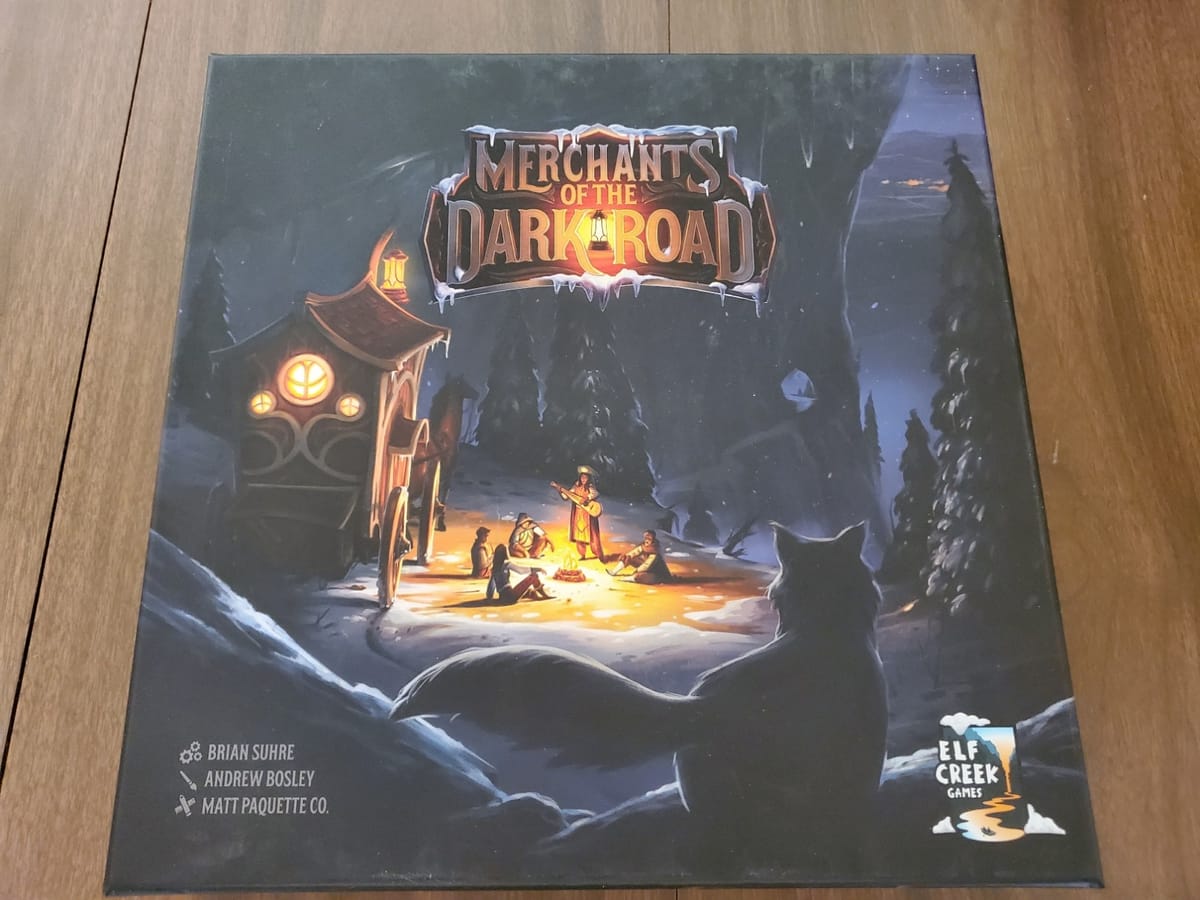
Merchants of the Dark Road is a solid trading/pick-up-and-deliver game with excellent production values. The game is set in the fantasy world of Lumi, where the entirety of Winter is spent in darkness. In the game, players take the role of merchants who buy, sell, transport, and deliver heroes and goods within the capital city of Highreach and to outlying towns over the span of 13 turns – 1 turn for each week of winter. Players will be competing over money, prestige, and (by way of good deeds) victory points.
Let’s start this review by highlighting one of the game’s best features: end game scoring. Players win by having the highest score at the end of the game; however, the base score is the lowest of either the amount of money the player has or the prestige the player has managed to accumulate. Any victory points gained from good deeds are added to the base score to get the final score. While Merchants of the Dark Road is not the first game to use this sort of scoring by any means, it is (in my opinion) a critically underused scoring mechanism and a welcome addition here.
Throughout each game there is a constant push and pull between trying to balance the accumulation of both money and prestige (as they are gained in different manners), as well as the use of money as an in-game commodity. Do you want to make a big investment of cash into goods to try and sell to heroes at a higher price? Or do you want to try to deliver those goods to outlying towns to fulfill a royal commission and gain prestige? Or do you want to just try and hold onto that cash, as each coin is effectively one point at the end of the game? The tension this creates is just great.
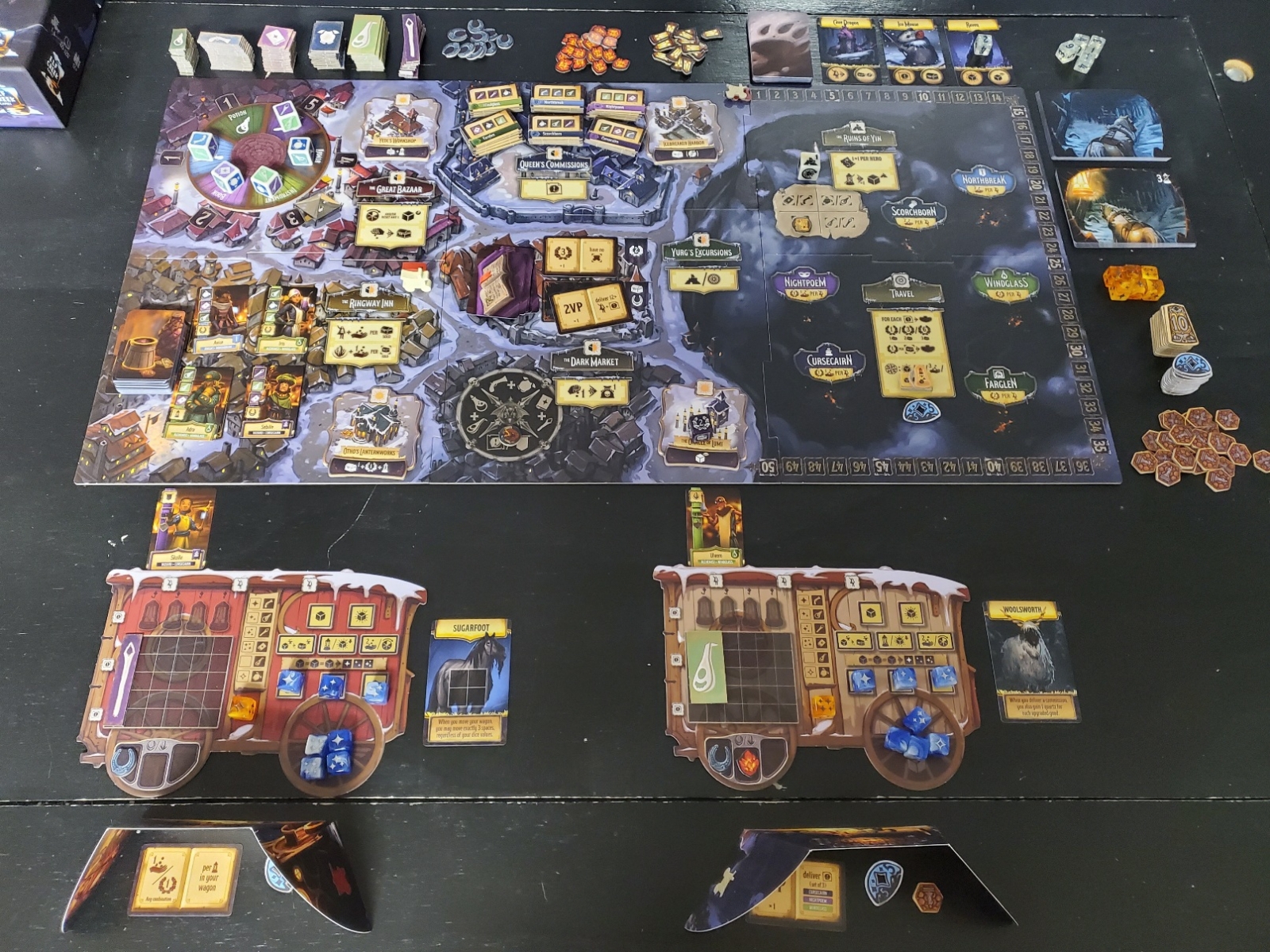
Now that I’ve covered the basic premise and how players win, let’s dive into how the game itself works. At the start of the game, each player will have 7 six-sided blue “night” dice and 1 six-sided orange “illuminated” die. Three night dice will be set to 1, 2, and 3 and placed in the first, second, and third dice slot, respectively; and the rest of the dice will be rolled. The illuminated die will be placed in it’s own special location (which can hold up to two illuminated dice) while the night dice will be placed in the players’ general dice pool. While the dice have custom symbols on them, the faces correspond to standard dice values: 1 solid star (1), 2 solid stars (2), 3 solid stars (3), 4 solid stars (4), no stars (5), and 1 empty star (6).

I want to take a moment to say that these custom dice are both a brilliant piece of design and something that completely threw certain people I played with for a loop. There are only five spaces players can move to on the board, and they are arranged in a linear and circular fashion. Moving five spaces, then, would result in a player ending up exactly where they started – hence the blank face replacing the traditional “5” and an alternative “1” replacing the traditional “6”. While I (and a number of people I played with) appreciated this and thought it was neat, it was a significant stumbling block for a few people I played with. In particular, the “1” and “6” caused confusion as they have the same symbol, but with the “1” filled in and the “6” being just an outline.
On each of the players’ turns, they will pick a night die from their pool and “bump” one of the dice in any one of the three dice slots up and into one of three corresponding actions. If a player doesn’t have any night dice in their pool, they remove one of their set aside night dice from the game, reroll any remaining, and then place any rolled dice back into their pool. Eventually, players will run out of dice, and, when no more dice are on anyone’s board, the game ends.
Bumping the die in slot 1 up will craft an item based on the die value moving into slot one. Bumping the die in slot 2 will allow a player to gain a lantern, or to activate 1 of their (up to 2) illuminated dice that turn. Bumping the die in slot 3 will allow the player to either gain coins, or turn the rondel that tracks the worth of goods. The night die that was bumped (or optionally the illuminated die if activated) is then used to determine which space the player moves to within the city. After moving, the night die is placed to the side of the player’s board and, if activated, the illuminated die is returned to the general supply.
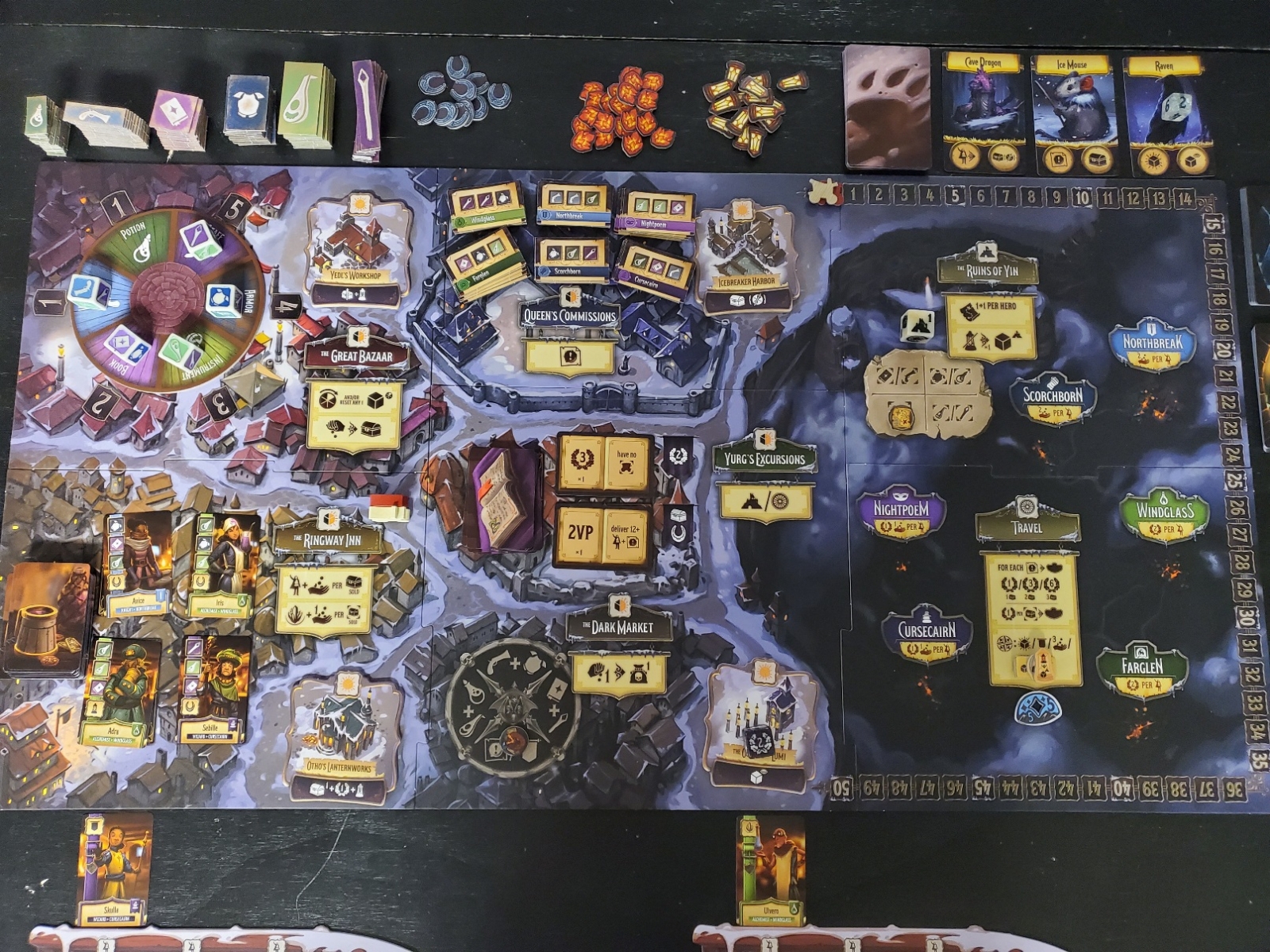
Each of the 5 spaces players can move to are situated between two different districts in the city, and each of the five districts does something different. The Great Bazar allows you to minorly fiddle with prices and quantities of available goods – and then buy goods. The Queen’s Commissions allows you to pick up a commission to take goods to an outlying town. The Dark Market lets you gain goods (and deeds and commissions) of questionable origin for cheap. The Ringway Inn is a place where you can pick up a hero and sell them some goods before escorting them to one of the outlying towns. Lastly, Yurg’s Excursions allows players to either visit some ancient ruins and find some superior quality (upgraded) goods (that sell for one additional coin or grant one additional prestige) or start a caravan to an outlying town (that any other players can join in on).
Traveling to an outlying town has some risks and possible rewards in the form of a random event, and allows traveling players to deliver heroes (for coins or prestige) and goods to outlying towns (completing commissions and gaining prestige). The player who started the caravan then can get one or two bonuses, including possible upgrades to their wagon, coins, good deeds, and illuminated dice.
If a player activated an illuminated die by bumping the die in slot 2, the player can visit both districts adjacent to the space in which the player ended their move as well as use the special building (if any) located adjacent to their space. Otherwise, the player must choose to visit only one of the two adjacent districts.
This dice-action-move mechanic is what really makes The Merchants of the Dark Road stand out. It’s an excellent little puzzle that you have to ruminate on every turn – rewarding players who can think ahead and plan out how they want their turns to play out far in advance. Not only do you have to think through where you are going to want to move to (both now and in the future) when you move dice up into the dice slots, you are going to have to think about what actions you are going to want to try and accomplish (both with your dice and where you will have moved), and that leads to all sorts of fun interconnected and conditional analysis to constantly be chewing on during other people’s turns.
However…
This dice-action-move mechanic can absolutely grind the game to a halt with certain players. I play a lot of games, and I play games I review with a lot of people – and there are some people and situations that can turn this game from being (relatively) quick and fun into a horrifying slog. I taught this game to several sets of players and, while there was always at least one new player in each set who grasped how the dice-action-move mechanic worked, there was always at least one new player who didn’t, and each player who didn’t immediately grasp the mechanic could easily add an hour or more onto the game’s play time. That said, once those players actually wrapped their heads around the mechanics, subsequent games played faster. Nevertheless, it is something I would be mindful of if you tend to play games with new groups of people all the time.
Similar, but worse, when it came to unnecessarily lengthening playtime and turning the game into a slog, were players who didn’t think through what they wanted to do until it was actually their turn. While the nested weave of interconnection between the actions and movement that will result from you making a simple selection of a die is awesome, you really need players who are going to think through all of that on other people’s turns. I’ve had what should have been snappy 1-2 hour games turn into all night affairs because certain players would only think through their possible actions on their turns. I didn’t even bother to try playing this game with anyone I know who are normally inclined to suffer analysis paralysis – and I wouldn’t suggest this game to anyone who is inclined to have analysis paralysis, or has such a person in their core game group.
Some things I didn’t touch on earlier, but deserve being discussed:

Merchants of the Dark Road comes with a booklet with solo play rules and two 4 game long campaigns/adventures. The solo rules were ok/on par for what I expect from a solo mode in a normally competitive game: the solo opponent (the Private Concern) feels very random in its actions and whether or not it will be a challenge from game to game. The campaigns/adventures seem like a fun idea, but some of the special objectives seem not just hard but entirely unrealistic.
For example, Adventure A3 requires visiting Yurg’s Excursions, choosing to explore the ruins instead of going out to visit the outlying towns (which is what you need to win the game), and roll a specific symbol found on one side of a six sided die that you can only roll if you have lanterns to spend. You only have 13 turns, and getting around the board to repeatedly visit this district so that you can roll the die even three times to have effectively a 50% shot at achieving the objective and still try to win is not hard in the traditional sense but just unrealistic and highly random. (As the dice roll is random, you could succeed the first time, the sixth time, or not at all.)
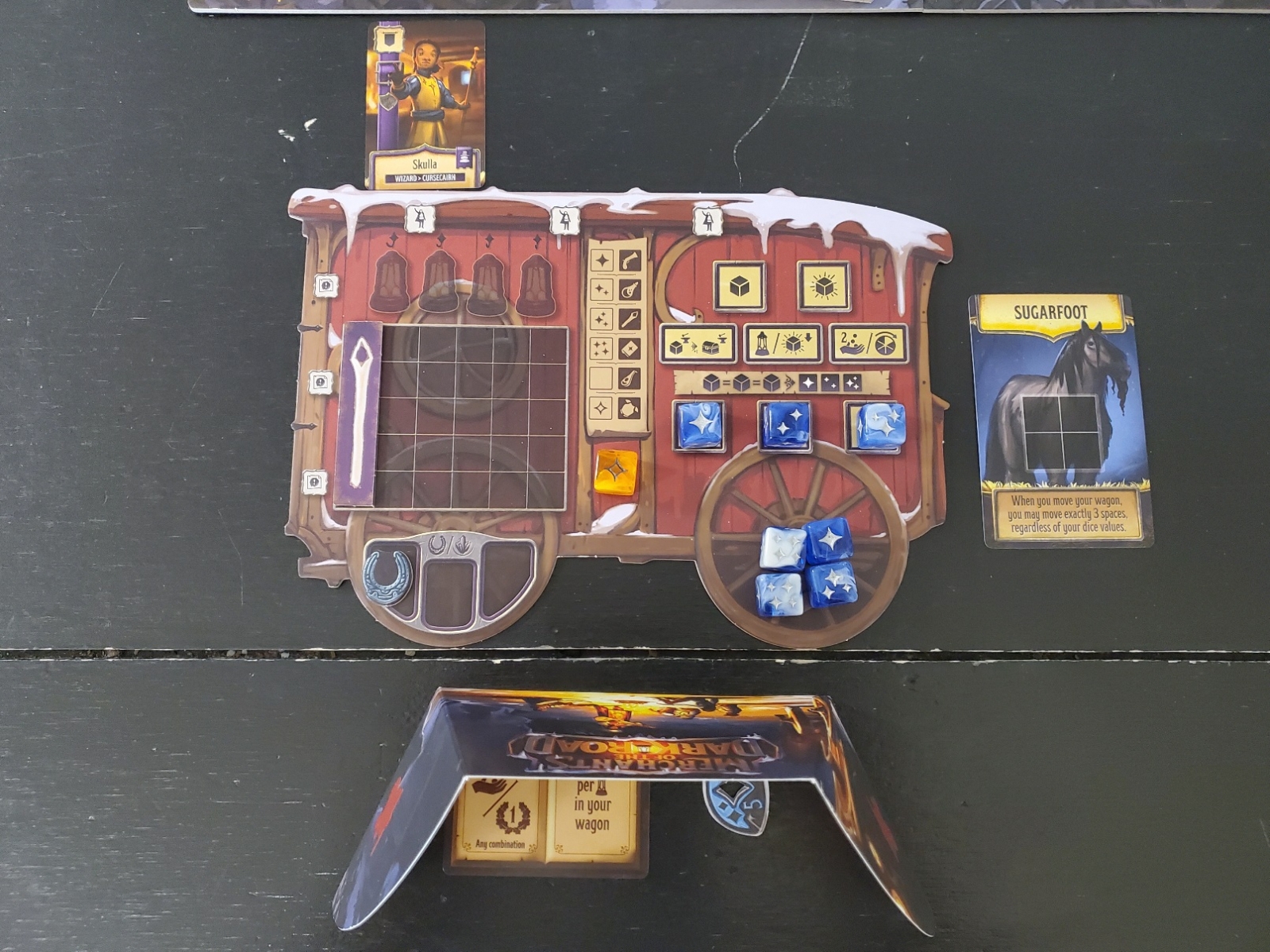
While everyone’s prestige score is public throughout the game, money is secret until the end of game scoring. The game comes with some thin cardboard player shield to hide your money behind. Unfortunately, cardboard coins and small player shields aren’t a great way to keep your money secret. I don’t know if the metal coins are worth it financially, but I would think the metal coins (with the different shape, weight, and textures) hidden in a closable pouch would certainly be a better experience (as you could more easily hide funds while still being able to figure out how much you have without looking).
Additionally, each player’s wagon has a set inventory space, each item has a different size, and you can only keep items you can fit in the space you have available (though you can freely rearrange what you are storing). This isn’t an abstraction. Rather, inventory management is a kinda fun, mini-spatial puzzle somewhat akin to Tetris. Unfortunately, the lack of the Kickstarter Deluxe or retail add-on dual-layered player boards/wagons is keenly felt here: it is very easy to unintentionally or unknowingly slide inventory pieces outside the allowed bounds of your inventory.
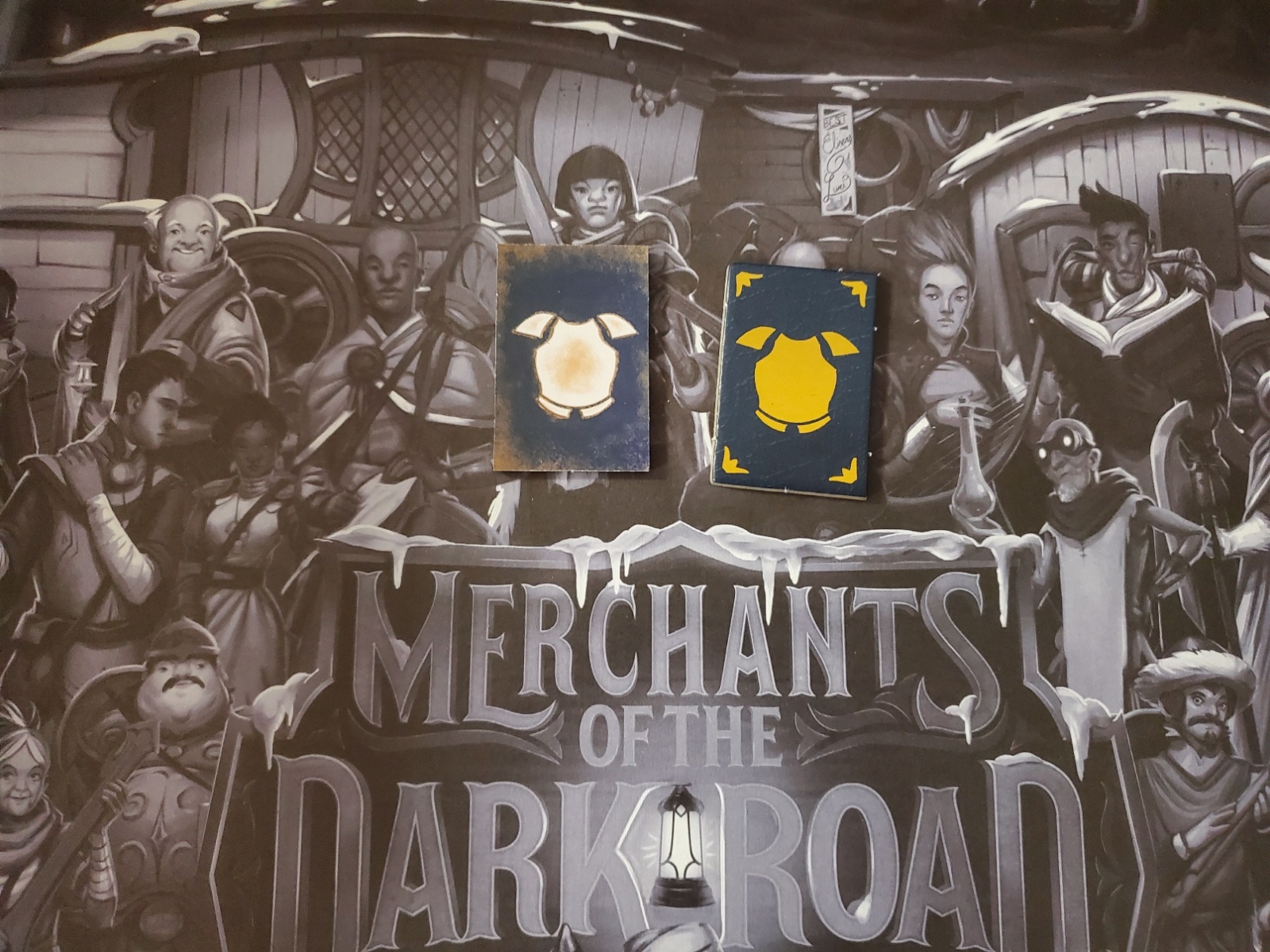
Speaking of inventory, the goods tokens are wonderfully and somewhat lavishly designed. Each good token is double sided. The common side has a normal color symbol representing the good. However, the upgraded side of each good token has a metallic gold version of the symbol, which looks pretty stunning in person – especially when you remember it’s just cardboard.
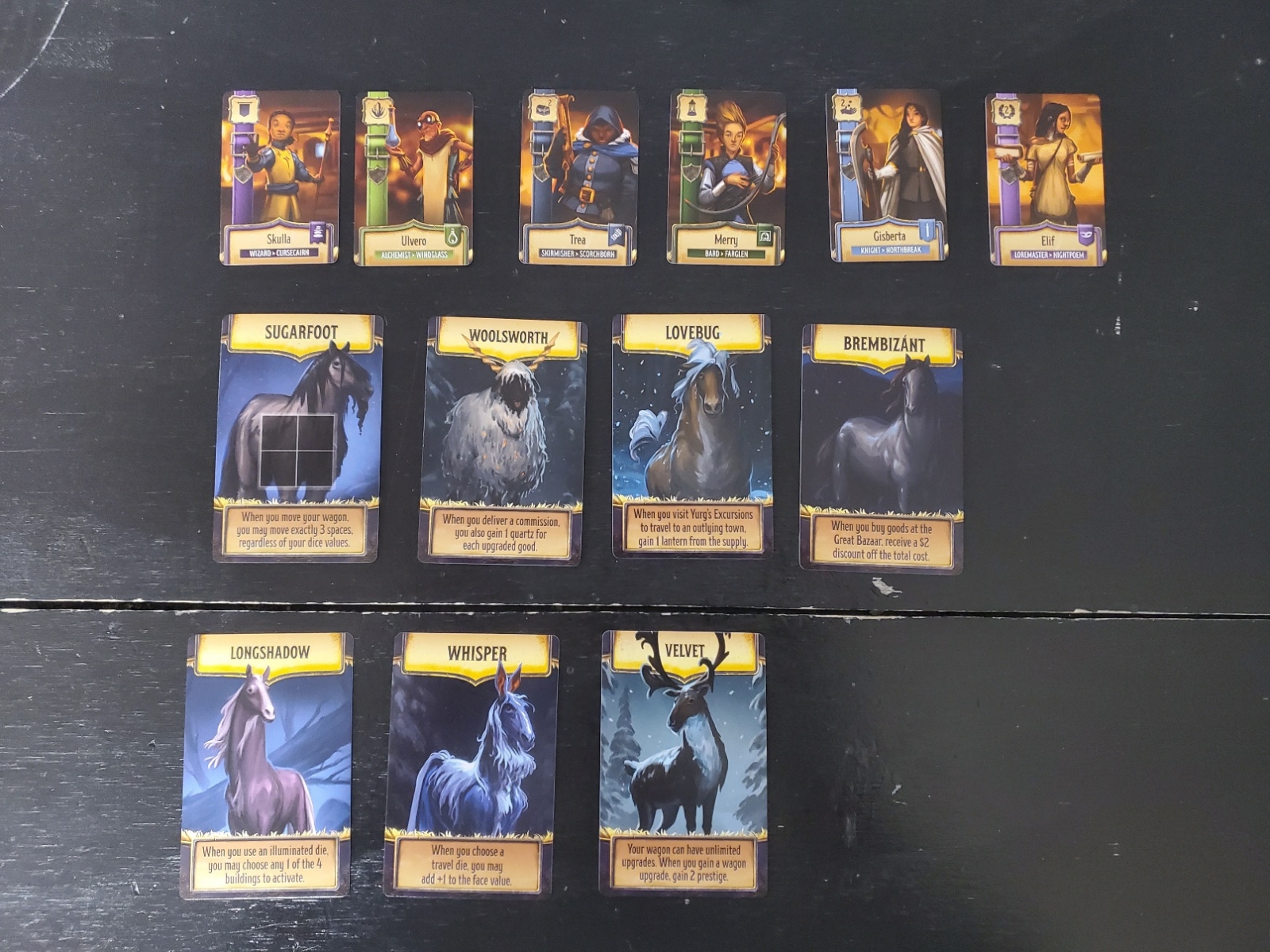
At the start of each game, players get a random starting hero and a random mount. These are not all made equal. The starting heroes offer different immediate bonuses which can then lead to certain players potentially being able to get off to a stronger start. In particular, Skulla gives you a good deed right off the bat, which can hugely impact end game scoring and aren’t that easy to get. On the opposite end of the spectrum, Ulvero grants 1 quartz, which is a one time use good that no player will probably use until after they’ve led a caravan to an outlying town, and which shares a small inventory window with another, arguably generally more useful item: horse shoes.
The mounts also vary widely in terms of utility, and (unlike starting heroes) you only get and have one mount throughout the entire game. Some have utility only in very narrow circumstances or have limited utility, while others have powerful and frequent game effects. Take Sugarfoot: this horse grants you four extra slots to hold items and can allow you to always move three spaces regardless of what your dice say. Both of these are very useful abilities – particularly always being able to choose to move 3 spaces. (The extra storage space is ridiculously good during the B1 & B2 solo adventures.)
Meanwhile, there’s Woolsworth who just grants you 1 quartz for delivering a commission with an upgraded good. Some players will not be in position to deliver upgraded goods until the late game – or possibly not at all; as mentioned before, quartz shares a limited inventory space with another good item; and some players might not have much use for quartz. Quartz is primarily used to fuel one-time abilities most animal companions you can pick up during your travels have. But you may not need the extra quartz (as you have plenty) or you may not really benefit from using the animal’s ability (as they can vary from animal to animal).
The game does have rules for drafting starting heroes and mounts, but that doesn’t really negate the possibility of there being good and not good options available to players. The first player to choose could still end up with a flat out better setup than the last player to choose. I’m not against asymmetrical powers. I, in fact, love asymmetrical powers in games. However, the gap here between starting heroes and mounts seems fairly large, and the game doesn’t have the strong reliance on player conflict (player “self balancing”) many games with high asymmetry tend to rely on.
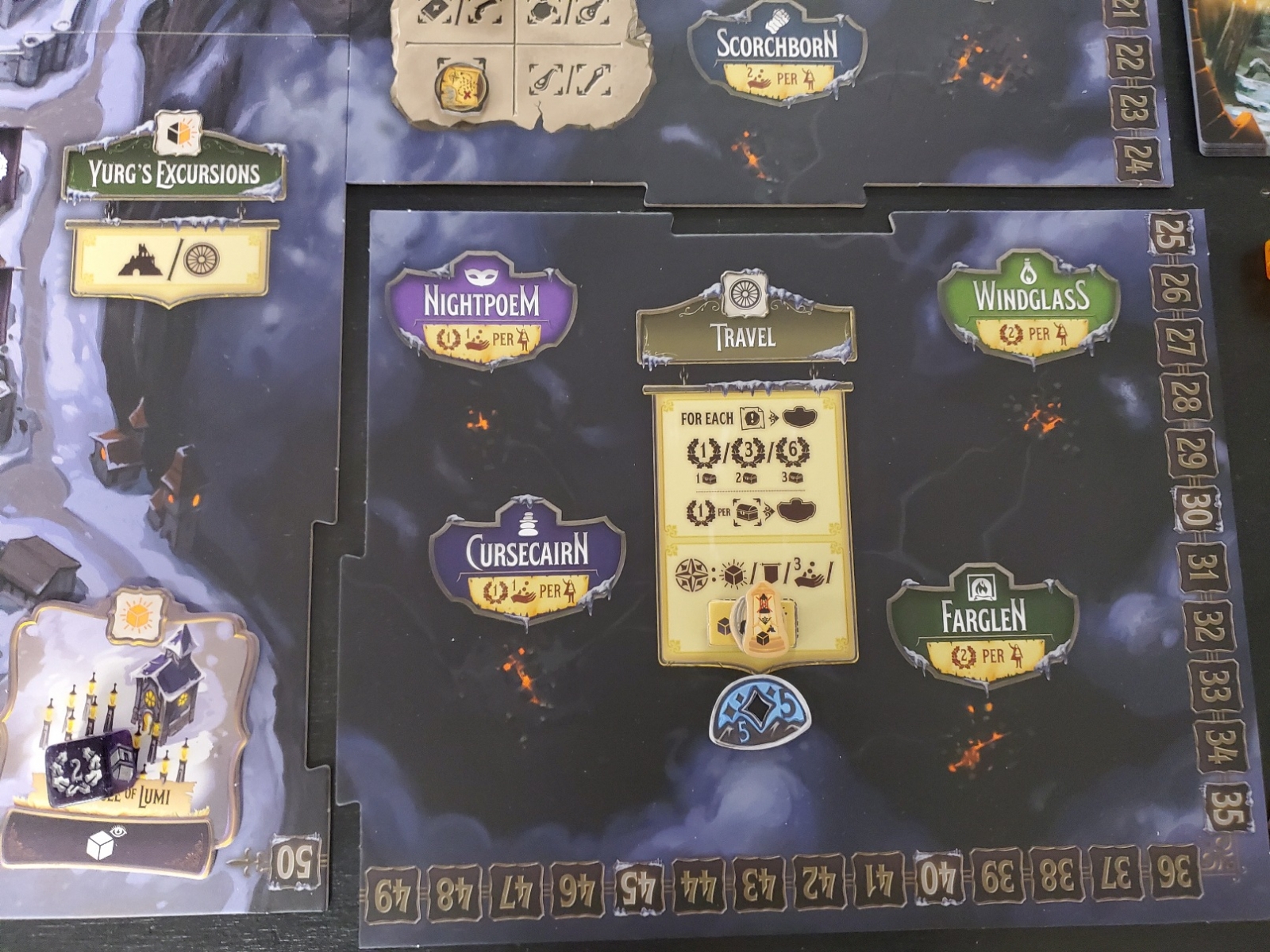
Leading a caravan to the outlying towns will result in gaining additional rewards – but not all rewards are equal. While most wagons can only have one upgrade, one of the upgrades allows you to generate more coins or generate prestige when using slot three on your wagon. If you get this early, you could potentially generate 11 prestige (and potentially increase your end game score significantly) from the upgrade alone. Meanwhile, there’s an upgrade that allows you to not have to spend lanterns to roll a die when searching the ruins from Yurg’s Expedition… which is fairly niche: it’s only available if you are at one space and only if you don’t want to lead a caravan to an outlying town.
Lastly, the design of this board is fantastic. The market’s rondel operates by way of a hidden magnet, which is very slick. Also, the way the board locks together like a puzzle both feels satisfying on a meta-level, and seems like a very smart way to easily modify the board in any future expansion.
Merchants of the Dark Road
Great
A solid trading/pick-up-and-deliver game with excellent production values. If you like this game, you’ll probably want to get all the blinged out components. However, you may want to pass on this game if you constantly play with new people, have players who only think through their potential moves and actions on their turn, and/or have players prone to analysis paralysis.
Pros
- The game is gorgeous, and the components are excellent.
- The dice-and-pool-based action+movement system can be a very fun puzzle.
- The fact that the end game scoring takes the lower of each player’s prestige and money creates an excellent tension between what actions to pursue to gain which of them throughout the game.
Cons
- If you like this game, you are probably going to want the Kickstarter Deluxe Edition AND the (separately purchased) metal coins - which isn’t going to be cheap.
- The dice-and-pool-based action+movement system is a puzzle that might really stymie some players.
- With the wrong players, this game can move along at a crawl, consuming entire evenings (4+ hours instead of 1-2 hours) and turn into an exercise in frustration.
- Some available abilities (mounts, wagon upgrades, etc) do not feel balanced.
